Nudes, Nudes, Electric Nudes
Some years ago, there were two or three automobile collisions each week at the intersection of 3rd St. and La Cienega in Los Angeles. Northbound cars on La Cienega would smash into southbound cars turning left onto 3rd St. I witnessed this sitcom from the cafe area of the now-sadly-demised Borders Books and Music at the northeast corner of the intersection. Every few evenings, there would be a squeal of tires, a crash, a customer by the window would check if anyone was hurt; then we'd all get on with our reading.
This is a story about how an artist -- me, it happens -- comes up with a series of paintings. There are many ways to make a series, and I will have other cases to share with you later on. In this instance, the series emerged from a dialogue in painting, with another artist, about a model we shared. It developed because of the inner logic of images.
I was at that Borders looking at art books and figurative painting magazines, primarily American Artist. What I was doing was emotionally extricating myself from my indoctrination in abstraction. It was a tremendous help to find that some contemporary artists were painting the figure, which was where my instincts were leading me. Over time, I identified and began to follow a constellation of painters. One of them was Patricia Watwood.
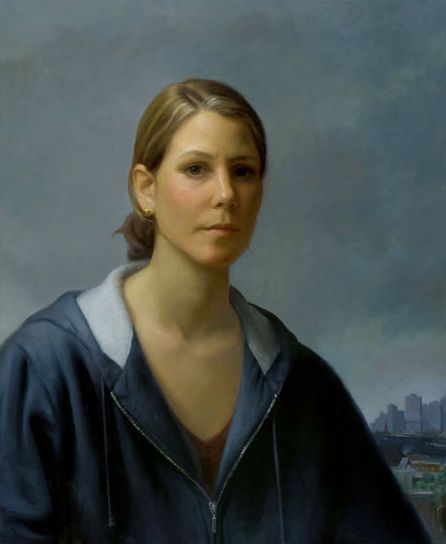
Watwood's work was not flashy. Rather, like Truffaut as a filmmaker, she was quiet in her methods. Like Truffaut, she seemed interested in reaching a clear and sympathetic understanding of her people. The muted quality of her work seemed to me both introverted, and generous, like a shy person who observes those around her with deep focus. If you'd like to see most of the paintings I'm citing here, she has a solo show, "Myths and Individuals," at Forbes Galleries until June 9th.
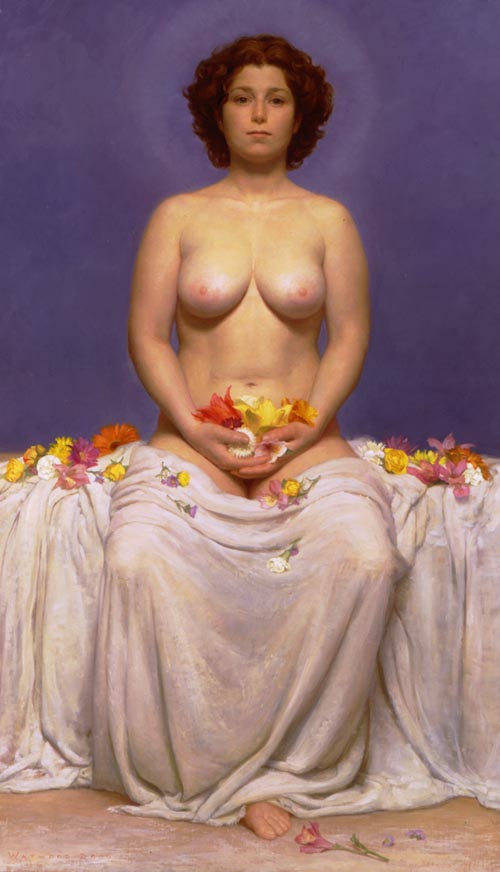
I moved to New York in 2006, and started hanging out with artists. Among the artists I eventually met was Patricia Watwood. I don't know her well, but I know her well enough to greet her at openings, and to have told her how much her work helped me when I was becoming self-aware as a serious figurative painter.
Quite independently from that, I began painting a model, Leah, who is really a very, very good model.
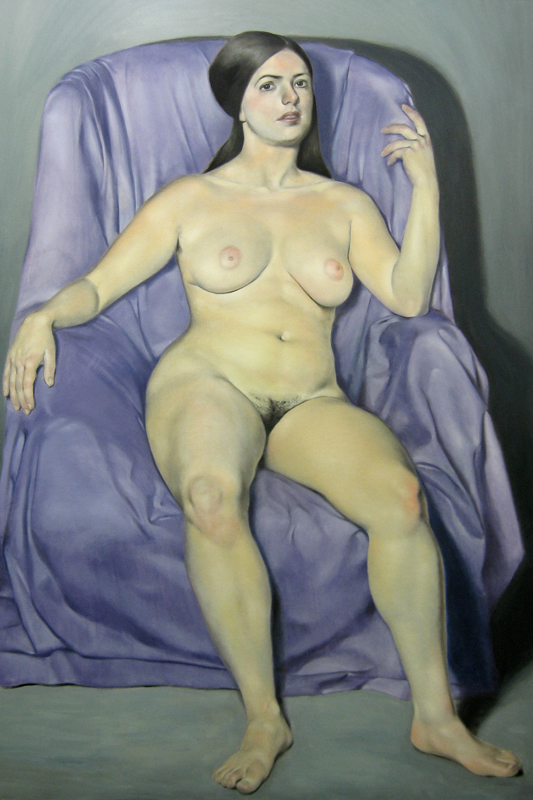
Leah's skilled modeling, in combination with her curvy build, made me think that Patricia might find her inspiring -- I had noticed that Patricia liked to paint curvy women. So I recommended them to one another, and it turned out to be a good match.
I was eager to see the work. I like to see paintings of models I work with by other painters. I'm crazy about my models, and I'm crazy about other painters. I want to share them with each other - I want to see what things they can give each other, that are different from the things the models and I can give one another. I want to see those marvelous paintings...
So I looked forward to Patricia's work with Leah. It is a cliche, but a true one, that painters divide into form/shape painters, and color painters. There are neurological reasons for this we can get into another time. I myself am a form painter. Patricia's a color painter. To make flesh fleshy, she carefully mixes and juxtaposes colors, a method she applied to Leah as well. Soon, we were both working on profiles of Leah. Here's mine:
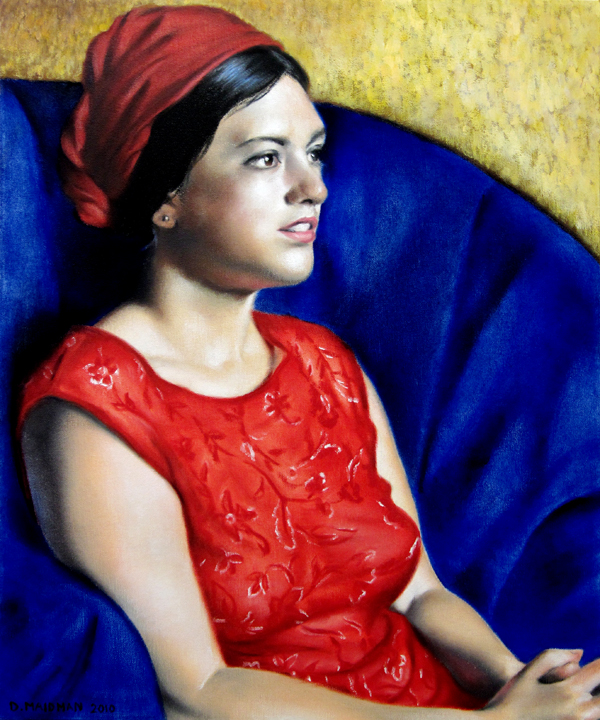
Here's hers:
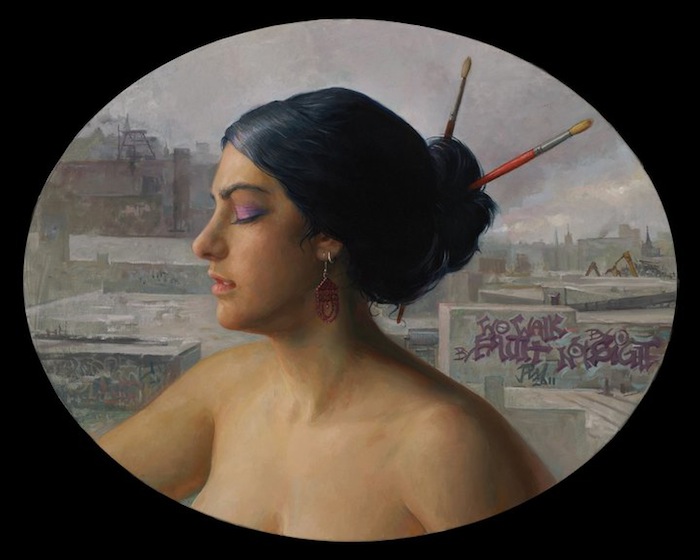
I liked Patricia's better. I had wanted to do a good profile of Leah for a long time, but I thought mine looked a little awkward. Only once I was done, and looked at Patricia's piece, did I realize what the problem was. There is a particular drama to Leah's profile, but the drama manifests best when the viewer is slightly below her. My viewpoint was slightly above her, giving the portrait a static quality I wasn't going for. It's a nice portrait, but there was something specific I wanted that isn't in it, and that exact thing was in Patricia's painting.
I didn't see any reason I couldn't paint a response to Patricia's painting -- I'm not above a little theft. So for my next Leah painting, I wholesale lifted the angle from Faith in the Wilderness.
Here's my response:
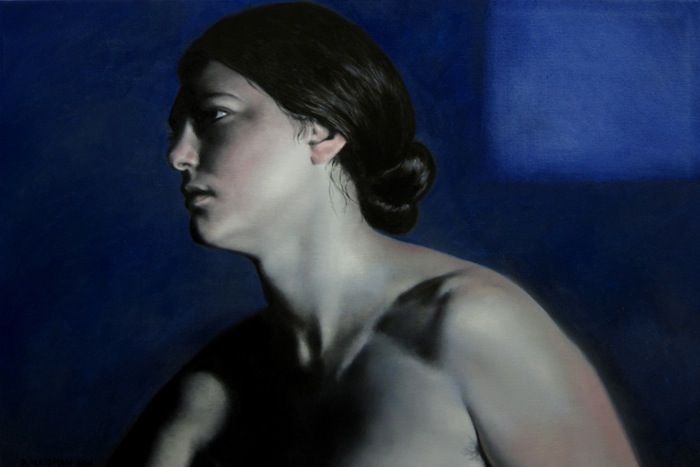
At that time, I was working in one-offs, but thinking about series. I wanted to do a series, but I had no idea how. What image could hold the attention of an artist through more than one painting? And yet, I thought that this Blue Leah painting had something to it -- it was my first attempt at painting distinctly over life-size, and I thought I had made some kind of a breakthrough in the intensity my gaze could sustain, in what observations I could haul out of myself and Leah.
And there was a very simple logic to it -- the logic of rotation. This is what I mean:
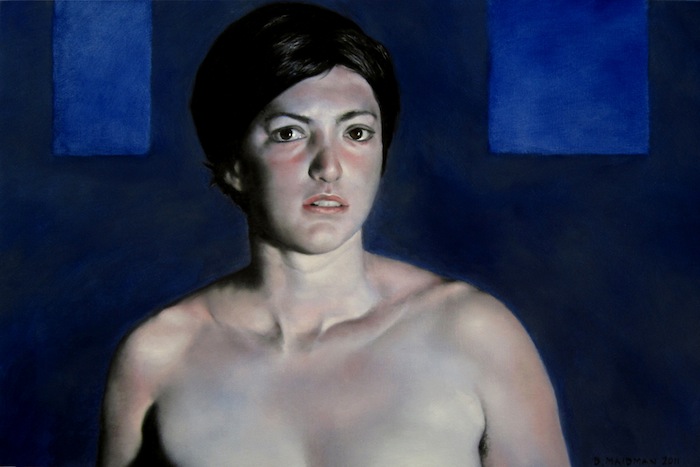
I was officially in love with this idea -- that if you blew up the face enough, you could stare, really stare, until the tiny structures and fleeting blushes, the tendons of personality, the architecture of the soul itself, finally came clear. I have been digging toward soul as long as I've been painting.
I cannot emphasize to you enough that this particular form of spiritual excavation is impossible without the commitment of the model. Many people think of the artist-model relationship as an objectifier-objectified dynamic. These people don't know anything about artists, models, or art.

As you draw and paint, you will find that your ability to see your model improves, as if your eyes were adjusting to the dark, or your sense of time expanding from the minute to the eon. With most of your models, your penetrating sight will eventually strike a layer of glass, the hitherto-shalt-thou-come-but-no-further of the model's privacy. Up to here -- all -- and beyond -- the concealment. This is absolutely fine in most circumstances, but it was nowhere near enough for theBlue Leah series.
Leah is not just a good model; she is an extraordinary model. She mirrors the degree of commitment of her artist to the work. She gives some when only some is brought to the work, and gives all when all is given. I threw everything I had at the personhood of the figures in the Blue Leah series, and, seeing this, so did Leah. To commit to being looked at, to the possibility of being seen, one must first commit to the statement, "This is what I am, and nothing else." This is the awful, vulnerable strength of the model. This commitment is what makes Leah extraordinary.
As I worked my way through the views of Leah's head, I began to see the rest of the series in my mind - similarly intense closeups of other parts of her body. But at this point, I faced a logic problem: when should I stop? The project is by its nature totalizing, and there is no endpoint to a total investigation. There is more information in the world, in a single person, than any number of paintings can capture. Should I paint 32 of them? 128? 1024? I could still be painting when Leah and I had both dropped into dust, and only the brush and paint were left behind.
I settled on 11. I am still working on them -- the completed ones are online here.
Patricia Watwood also recognized that she had lucked into a rare resource in Leah, and has worked with her more or less continuously since I introduced them.

When Patricia's paintings joined the body of work that guided me toward making a serious attempt at figurative painting, part of the guidance was just basic jealousy. I wanted to be able to paint those paintings.
Now, so many miles and years away from the hellacious corner of 3rd St. and La Cienega, I find I am like Aeschylus (I think it's Aeschylus) who, in his old age, breathed a sigh of relief that his lust had died down at last. Which is to say: I continue to have an immense affection for Patricia's work, but I no longer suffer from a lust to be Watwood the painter. Now, I recognize what I am, and what I am not; I am pleased with what I am, and at peace with what I ain't...
For the first time, I can look at Patricia's work without toothed envy: happy only that it exists, that it has its distinctive nature, and that I have a chance to enjoy it. Here is her most recent completed Leah painting, which I would buy if I had lots of money:
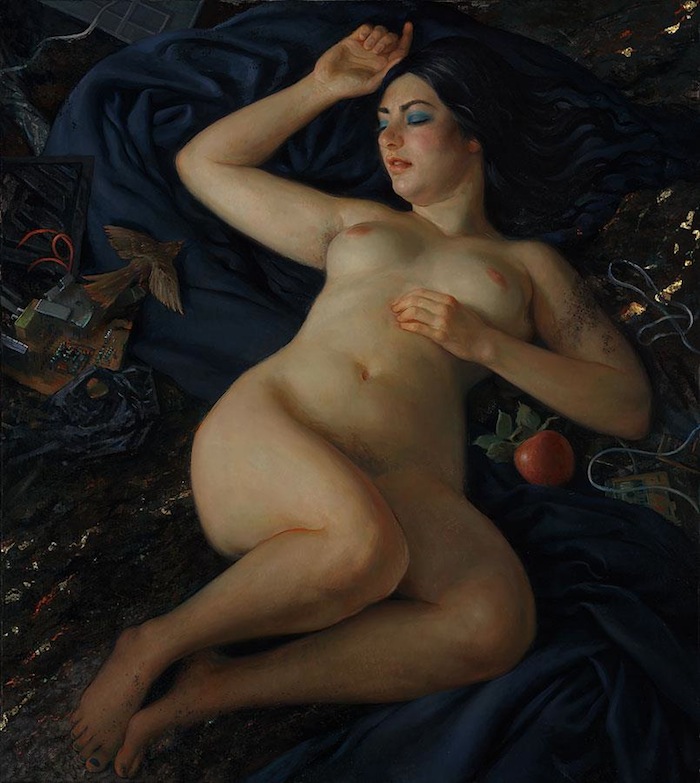
How different her vision of Leah is from mine! And yet, how marvelous, how sheerly sparkling in its reflection of what she brings to her encounter with her paint and our shared model. How excellent is this, that there is more than one painter in the world, and that we are different from one another?
So that's the story of how a series happened. I am more grateful than I can say, to Leah, for letting me study her, and to Patricia, for quietly, generously, helping to show me how.
ENDNOTES
1. If you're in New York, and you dig figurative painting, seriously, go by Forbes to see "Myths and Individuals" before it ends on June 9th. Here's that link again.
2. All Patricia Watwood paintings appear with the permission of Patricia Watwood.
